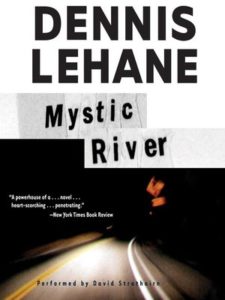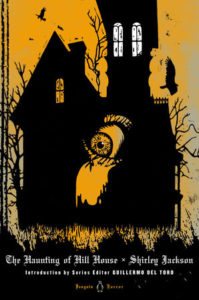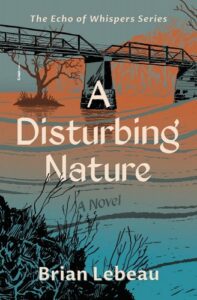Tucked under the autumn foliage and blended into spring’s vibrant colors, floating unseen in the stagnant air of a summer heatwave and drifting quietly under a winter blizzard, New England’s romantic landscapes conceal the mystical creatures, myths, and legends they harbor, affording a dreamlike setting with unsettling undercurrents. Seeded with independent spirit and rooted in puritanical values, New England’s path has been the story of America. For its climate, mythology, and history, New England continues to provide an excellent backdrop for mysteries, chillers, dark romances, and psychological thrillers.
There’s no denying the suspenseful tone set by the sinister storm drains of Stephen King’s It, the polluted waters of Dennis Lehane’s Mystic River, and the dizzying August heat and humidity in Sarah Schmidt’s See What I Have Done. The woods of Rhode Island and southeastern Massachusetts were my drug of choice for my debut novel, A Disturbing Nature. Raised in Fall River, Massachusetts, I endured a childhood education littered with historical accounts of Lizzie Borden, the Salem witch trials, and the tragic whaling tales of nearby New Bedford. Knowing A Disturbing Nature would be dark and employing the well-worn adage, “write what you know,” southern New England offered the perfect setting. As I collected my thoughts to begin writing, I reflected on other New England-based stories that have inspired me. Below are eight novels that have elements I find both fascinating and disturbing.

Mystic River by Dennis Lehane, published in 2001, is a seminal psychological thriller and ranks among my all-time favorite novels. The story follows three childhood friends who navigate adulthood burdened by past trauma. Things come to a climax after the murder of one of their daughters. As the story plays out in a working-class neighborhood of Boston, Lehane uses the nearby Mystic River as a metaphor for the past, the future, and karma. Despite being dirty and polluted, the river washes characters clean of their sins. Mystic River gets us thinking about the lingering impact of childhood trauma and leaves us wondering how we might’ve turned out if certain events had unfolded differently.

I started my final year of college in 1986, around the same time Stephen King released It. After reading his novel, I was glad I wasn’t fifteen when it came out. It unfolds as a disturbing coming-of-age story that blends horror and dark fantasy. King covers themes such as the power of fear and the different forms of evil, complicated by character memory gaps and loyalty tests. And everything plays out in the small town of Derry, Maine, where seven friends unite to combat supernatural forces lurking in the marshy wastelands shrouded under sheets of torrential New England rain. It makes us question what we fear and how much power threats, real or imagined, have over us.

Published in 2020, Megan Collins’ Behind the Red Door is a mysterious psychological thriller that takes place in New Hampshire. A woman struggles with memories from her past after a girl from her youth goes missing for a second time. When she revisits her childhood home, the main character has trouble distinguishing truth from fiction and reoccurring nightmares from reality. An unreliable narrator and a primary character plagued with suppressed memories unwind this twisted and haunting tale. The classic New England settings that include dark forests and creepy cabins are memorable, as is the thought-provoking writing style.

The Secret History by Donna Tartt, 1992, utilizes the inverted detective structure when a student reflects on the circumstances surrounding a friend’s murder years prior. Set in Vermont, The Secret History explores themes such as the burden of secrets, corruption in academia, fascination with death, and the philosophy of fate. The main character is from sunny California and becomes buried under New England rain and snow and a mountain of books as he works to acclimate himself. The story focuses on the lingering effects of a murder on the characters rather than the murder itself, making it more relatable.

In the strictest sense, The Haunting of Hill House by Shirley Jackson, published in 1959, is a gothic horror novel. However, because Jackson uses complicated character relationships and layers them with mysterious events in the house, it qualifies as a supernatural psychological thriller. Hill House is set in Massachusetts, southwest of Boston. Setting and theme cross over, as this house is not a home, with its unwelcoming aura and the dread and isolation it harbors. The beauty of this work is that it makes us wonder about the nature of relationships on our psyche, even relationships with non-living things.

Sarah Schmidt’s See What I Have Done came out in 2017. It’s a fictional account of the historical Lizzie Borden murders in my hometown. Schmidt incorporates multiple perspectives for the events of August 4th, 1892, a sweltering summer day in Fall River, Massachusetts. As a psychological thriller, this work of historical fiction absorbs us, with characters questioning their own accounts of what happened as other characters are shown to have had a motive to kill besides Lizzie. It examines what we think we know and offers a refreshing take on a time-honored mystery.

Being a true master of psychological thrillers and a personal favorite, Dennis Lehane appears twice on this list, releasing another brilliant novel in 2003, Shutter Island. Crossing into other genres, Shutter Island is also a period piece with detective, horror, and fantasy elements. In Boston Harbor, two officials arrive on fictitious Shutter Island in 1954 to find a missing patient accused of murder. Lehane combines the depression of a mental facility, the isolation of an island, and the desperation of a hurricane to create a haunting scene stretching across four turbulent days. Themes of tension between past and future are addressed, along with sanity among the presumed sane.

Published in 1850, almost a century before the psychological thriller genre, Nathaniel Hawthorne’s Scarlet Letter represents the standard for Dark Romance, incorporating themes still relevant today, including the prejudice, hate, and jealousy aimed at those who do not conform. His story offers the reader insight into the treatment of New England scenery at that time. In addition to the mysterious woods that the locals fear, Hawthorne also makes excellent use of New England’s spiritual and mystical folklore. And in proper psychological thriller form, Hawthorne leaves us wondering where the real monsters reside.
***


















